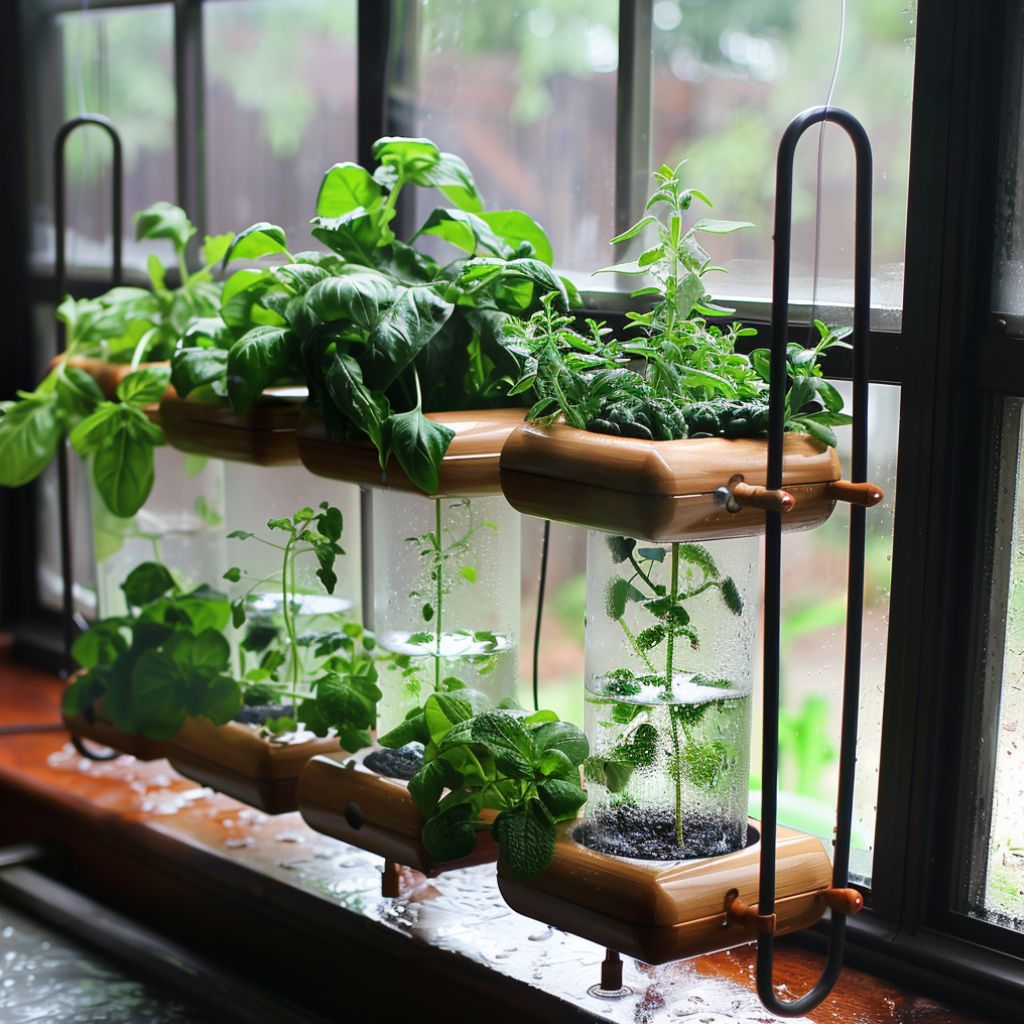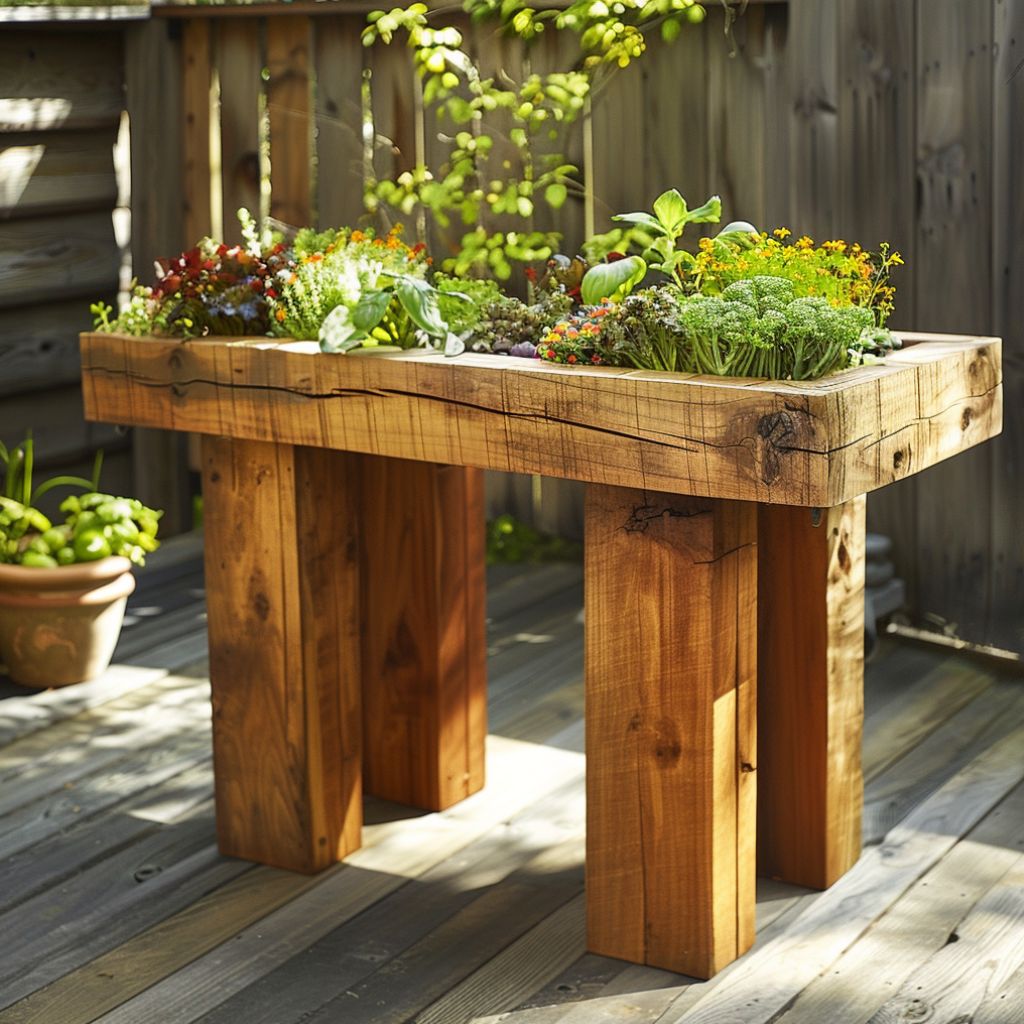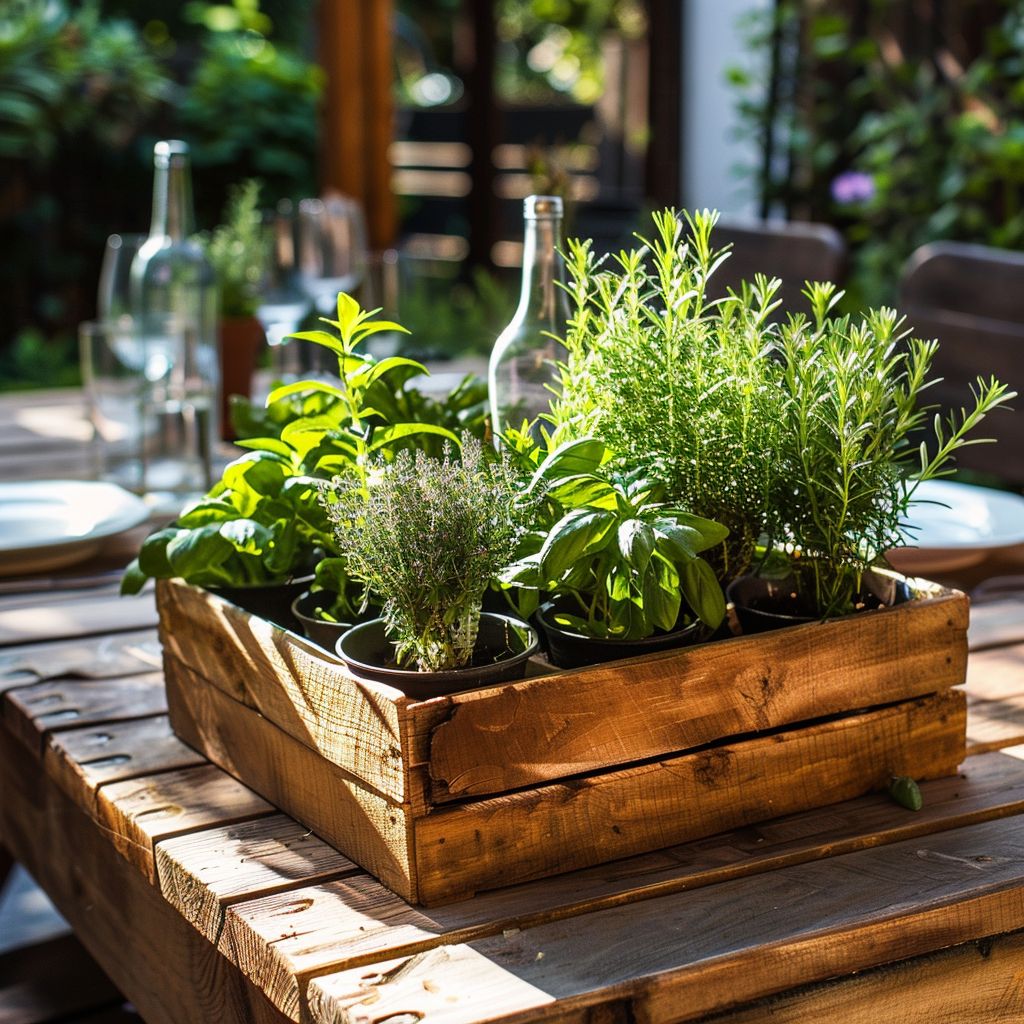Dreaming of a green oasis but short on space or gardening expertise? Fear not, an herb garden may well just be your perfect solution. These user-friendly plants offer a fantastic way for budding gardeners to hone their skills, without the intensity of maintaining a full-blown vegetable or cut-flower garden.
Whether you’ve got a tiny backyard, a spare ledge, or even just a doorstep, there’s an herb garden setup that’s just right for you. From the delightful aroma to their culinary uses, herbs can add a unique touch to your space. And the best part? You don’t need a green thumb to get started.
Creative Herb Garden Ideas for Small Spaces
These garden design ideas will help you make the most out of any limited area. By getting creative with containers, going vertical, and choosing compact varieties, you can create a lush garden oasis.
Here are some inspiring ideas to help you get started:
#1. Windowsill Herb Gardens

One of the simplest ways to grow herbs indoors is with a sunny windowsill garden. Use small pots or containers to grow low-maintenance herbs like basil, parsley, mint, and chives right on the windowsill. The key is to choose a window that gets at least 6 hours of sunlight per day. This ensures your herbs thrive and stay healthy.
#2. Hanging Baskets
Hanging baskets are perfect for trailing herbs like rosemary, oregano, and thyme. By suspending them from overhead, you save precious floor space while creating an attractive display. Hanging baskets also help deter pests and keep herbs away from pets, making them a practical and stylish choice.
#3. Vertical Gardens
If you’re really tight on space, go vertical! Create a living wall of herbs using a shoe organizer, wooden crates, or stacked pots. This approach maximizes every inch for growing. Vertical gardens work amazingly well on balconies, patios, or against a sunny wall. They not only save space but also add a unique visual appeal to your outdoor area.
#4. Raised Garden Beds

For a more traditional approach, build a small raised garden bed and dedicate a section or row to your favorite herbs mixed with edible flowers, vegetables, or annuals. Raised beds provide good drainage, which many herbs crave, and they make it easier to manage soil quality and moisture levels.
#5. Container Gardens
Get creative by repurposing all kinds of containers as herb planters—terracotta pots, mugs, tin cans, buckets, or upcycled containers with proper drainage holes. Group them together in a sunny spot to create a charming herb container garden. This method allows you to move the containers around to catch the best light or protect them from harsh weather.
#6. Window Boxes
Shallow-rooted herbs like mint, oregano, rosemary, and thyme thrive in the excellent drainage provided by window boxes. Plus, window boxes add a pop of greenery to your exterior, enhancing the overall look of your home while keeping fresh herbs within easy reach.
#7. Hydroponic Gardens

For an ultra-low-maintenance option indoors, set up a hydroponic system to grow herbs in just water and nutrients, with no soil required. It’s clean, pest-free, and perfect for those who want fresh herbs without the hassle of traditional gardening.
The possibilities are endless for herb gardens in small spaces! By getting creative with containers, trellises, hanging baskets, and vertical gardens, you can make the most of any area. Choose compact varieties, provide plenty of sun, and enjoy harvesting fresh herbs just steps from your kitchen. Happy gardening!
Selecting the Right Location for Your Herb Garden
Finding the perfect spot for your herb garden can significantly impact the health and growth of your herbs. This section provides you with key considerations when picking a location for your herb garden, both outdoors and indoors.
Factors to Consider for Outdoor Herb Gardens
When planning an outdoor herb garden, several factors come into play. Firstly, sunlight availability is essential for healthy growth. Most herbs need at least 6 hours of sunlight each day. Secondly, consider the quality of your soil. For a successful herb garden, especially in clay conditions, select effective plants for clay soil that thrive in well-drained environments and aren’t prone to waterlogging.
Make sure you have a rain and sun-shielding system for unstable weather conditions. Metal and treated wooden tables can withstand rain and sun, making them great choices for outdoor herb gardening.

Additionally, think about table placement. Position your herb pots on a table strategically placed to afford adequate sunlight and shadow balance. This way, you can also overlap your herb garden over other plants to maximize space.
Options for Indoor Herb Gardens
If you don’t have outdoor space, fear not, an indoor herb garden can be just as delightful. For indoor herb gardening, sunlight remains crucial. Choose a spot where your herbs can get at least 6 hours of light, such as a windowsill or a balcony lit by sunshine.
Consider vertical gardening if the surface space is limited. Vertical gardens, whether they’re shelf units lined up against a garden wall or pots fixed onto a large vertical frame, are space-friendly and quite popular.
However, remember to select pots of adequate size to avoid root overgrowth and to ensure your herbs grow well. And remember, as the herbs start to outgrow their pots, it’s essential to move them to larger pots or garden soil, for their continued growth.
Lastly, don’t disregard the aesthetic aspect. Adding fairy lights, soft furnishings in bold colours, and outdoor rugs can make your herb garden an inviting space that you cherish and visitors admire.
Planning Your Herb Garden Layout
You’ve seen the benefits and versatility of herb gardens, now let’s shape your individual garden scenario. This step involves choosing a suitable layout for your herb garden, whether your available space is petite or expansive.
Design Ideas for Small Spaces

Taking advantage of available space can be fun and inventive. Think about employing vertical gardens. They can be as simple as a few shelf units against your garden wall or a large metal frame laced with pots. This design technique not only utilises your space efficiently but also makes watering a breeze, as water trickles down from the top herbs to those below.
Another savvy approach to small space gardening is the use of tables. Position a table carefully to provide sunlight for your herbs and shade for other plants beneath it. You can recycle an old wooden table from your garage or acquire a metal table that’s durable against weather elements.
Raised Herb Garden Ideas
An engaging design feature for your backyard could be a spiral herb garden, a great example of landscaping solutions for backyards. Start by arranging stones around the perimeter to form a spiral shape, then fill it with soil. Adding some homemade compost to the base will enrich the soil quality and support healthy plant growth.
Tips for Larger Herb Gardens
With more room at your disposal, you can explore arranging your herbs alongside your dining space outdoors, which can add to your al fresco meal experiences. The combination of pleasant fragrances and the visual appeal of herbs can enhance the overall ambience.
Furthermore, strategically selected herbs such as basil, lemongrass, mint, and rosemary have the added benefit of repelling pests, improving your backyard comfort even further.
Remember, whether it’s a small space or ample garden, a well-thought-out layout can offer not just convenience, but also an attractive feature that adds character to your backyard. The resulting herb garden then becomes a perfect blend of utility and aesthetic appeal.
Choosing Herbs for Your Garden
Starting your herb garden journey can be exciting yet overwhelming. To ease the process, let’s focus on two essential steps: identifying beginner-friendly herbs and strategically selecting herbs to match your climate and cuisine.
Best Herbs for Beginners
Embarking on your herb gardening adventure doesn’t need to be difficult. Starting with robust, easy-to-grow herbs can give you a sense of accomplishment early on. Mediterranean-origin herbs like oregano, rosemary, basil, and sage are ideal choices as they endure hot, dry conditions well. Mint and lemon balm offer refreshing tastes but be aware, they are a bit boisterous and can overrun other herbs, so it’s best to plant them in pots.
How to Choose Herbs Based on Climate and Cuisine
Creating your herb garden isn’t simply about planting and nurturing. It’s also about choosing the right herbs for your specific climate and cuisine. If you’re a fan of Thai cuisine, consider growing Thai basil. In addition to its sweet aroma, it grows large, purple, bee-attracting blooms.
As for the climate, if you reside in a place with mild or warm winters, your chosen herbs will likely continue to thrive throughout the year. Hence, picking herbs that match your location’s climate can lead to a fruitful, year-round harvest.
Know that your herb garden, whether in pots, planters, or an outdoor patch, offers countless possibilities. Pack your chosen herbs into your garden design and get ready to tend them with love. Your reward will be a thriving garden and a fresh supply of herbs for your kitchen.
Essential Tools and Equipment for Herb Gardening
Nurturing your herb garden demands specific equipment to make the process easier and your plants healthier. Let’s examine some fundamental tools and innovative gadgets that are practical for herb gardening.
Basic Tools for Planting and Maintenance
With the right tools, planting and maintaining your herb garden can be a breeze. Thus, you’ll require these essentials:
- Gardening gloves: Protects your hands from dirt and minor injuries. They are absolute must-haves for any gardening activity.
- Hand trowel: Ideal for digging small holes, transplanting plants, or mixing in compost or fertiliser. In a herb garden, they’re extremely handy.
- Pruning shears: Occasionally, your herbs need a trim to encourage healthier growth. Shears are perfect for this task, allowing you to clip away with precision.
- Watering can or hose with adjustable nozzle: Watering is crucial to plant health. These tools help ensure your herbs receive the right amount without overhydration.
- Compost or fertiliser: These ensure your soil is nutrient-rich, promoting the sturdy growth of herbs.
Innovative Gadgets for Efficient Herb Growing
Aside from basic tools, there’s a bunch of innovative devices that can ramp up efficiency in herb gardening:
- Soil pH and moisture meters: These gadgets supply accurate readings of your soil’s pH and moisture levels, eliminating guesswork, and ensuring your herbs get the right environment to thrive.
- Automatic Herb Watering Systems: If you’re away often, these systems are your solution. They’re set to water your herbs at regular intervals, keeping them hydrated even in your absence.
- Solar-powered LED plant lights: These energy-saving lights provide your indoor herbs with the necessary light spectrum for growth, mimicking sunlight where there’s a lack.
- Smart Garden Monitors: These are little devices you stick into your herb’s soil. They track sunlight, temperature, moisture and fertilizer levels. Synced to an app, they provide you real-time updates and care tips for your herbs.
By deploying these essential tools and tech, not only do you make herb growing simpler but you’re on track for a healthier yield.
Step-by-Step Guide to Starting Your Herb Garden
Initiate your journey into the fascinating world of herb gardening with this straight-forward guide. Let’s delve into the specifics and get hands-on experience in creating your verdant haven.
Preparing the Soil
Before sowing the seeds or planting seedlings, it’s crucial to properly prep the soil. Start off by removing any spent herbs or leaf debris, keeping the space crisp and fresh – a welcoming bed for new plants.
Arm yourself with a rake, pull out the old herbs and rake the top gently, ensuring no leaf debris is left behind, as they tend to provide havens for pests. Next, improve the fertility of the soil by adding a couple of inches of fresh compost and rake it in smoothly.
Planting Techniques for Herb Seeds and Seedlings
Various herbs have differing soil moisture preferences, with the likes of dill, cilantro, parsley, and basil leaning towards consistently moist soil. Keep in mind that you should avoid planting mint with other herbs as it intrudes on the root growth of its neighbours. Combine the plants as optimally as possible considering they tend to grow vertically rather than spreading out.
Frequent harvesting will also ensure healthy growth and ample access to light and air, which are indispensable for their growth. Don’t forget to water the container gently after planting, nourishing the seeds to sprout into a healthy yield.
Maintaining a Healthy Herb Garden
Keeping your herb garden in top condition is a critical aspect of gardening that will ensure your chosen herbs thrive. Here, we’ll delve into practical tips and guidelines to make your gardening journey easier and more successful.
Regular Care Tips

Routine care of your herb garden is essential for longevity. Herbs, like any plants, enjoy regular watering, so keep the soil moist, but avoid waterlogging. Good organic soil coupled with compost ensures your herb’s health – so, don’t skimp on it.
Maintain a balance by considering factors like sunlight exposure, climate, and herb variety. Remember, your herbs may need occasional fertilization – but always follow the dosage instructions to prevent over-fertilizing.
Managing Pests and Diseases Naturally
Pests and diseases are a real challenge in any garden – herb gardens are no different. Start by clearing any leaf debris that may well provide a safe haven for pests. Exploring natural pest-resistant plantings such as marigolds, and ground cover like mint can help.
In the event of disease, remove and destroy affected herbs to contain spread. For an organic solution, try using natural insecticides or consider introducing beneficial insects like ladybirds into your garden.
Winter Care for Herb Gardens
Winter can be a rough season for your herb garden. To ensure your precious plants survive, consider using polytunnels. These polythene structures protect your herbs from severe weather, prolonging growing seasons, and increasing growth. If you’re using containers, consider moving them indoors for greater control over temperature.
Lastly, remember, even during winter, maintain a regular watering and care routine – it may well just make the difference between survival and extinction for your herbs.
Up next: Succulent Garden Ideas: 8 Key Principles for Beautiful and Functional Gardens
